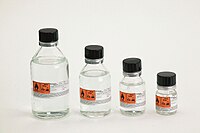
Photo from wikipedia
Abstract A facile route for the N/P doped MoS2@ poly (cyclotriphosphazene-co-4,4-sulfonyldiphenol)-C (MoS2@PZS-C) yolk shell nanostructure has been presented. The obtained MoS2@PZS-C nanospheres has a unique advantage of yolk shell morphology,… Click to show full abstract
Abstract A facile route for the N/P doped MoS2@ poly (cyclotriphosphazene-co-4,4-sulfonyldiphenol)-C (MoS2@PZS-C) yolk shell nanostructure has been presented. The obtained MoS2@PZS-C nanospheres has a unique advantage of yolk shell morphology, due to the internal void space (floc porous structure formed by oligomers) with a high surface area (573.9 m2 g−1), which can not only provide enough reaction sites to store electrical charge, but also accelerate the reaching of reaction sites by ions flux permeation. Even if the volume expansion causes the structure to be destroyed, the pulverized active material is still wrapped in the conductive material to achieve stable electrical contact. Using the MoS2@PZS-C nanospheres as anode material in lithium-ion batteries (LIBs), it presented enhanced cycle stability with high specific capacity (1245 mA h·g−1) and good rate capability. At the same time, DFT calculations showed that N, P, S doped modified carbon structure can improve the binding energy of materials and lithium ion/atoms, and change the local charge density of materials to produce more active sites. What’s more, the defects caused by doping can increase the electron chemical activity and electron transport rate of the material. It reveals the cause of the PZS-C electrode with high electrochemical performance.
Journal Title: Electrochimica Acta
Year Published: 2020
Link to full text (if available)
Share on Social Media: Sign Up to like & get
recommendations!